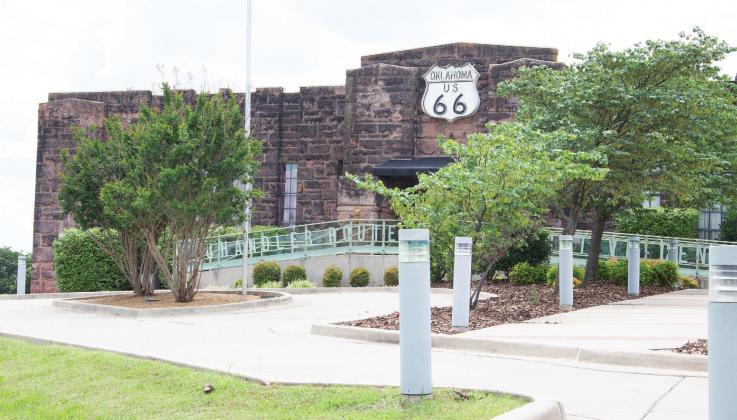Chandler Interpretive Center and historic Armory
With concerns over COVID-19 still looming, travel this summer may prove difficult. But that doesn’t mean that individuals can’t explore the attractions in their own backyard, that they may never have visited before.
Route 66, known alternately as the “Mother Road” and “America’s Highway,” was formed in the 1920s as the first highway connecting Chicago and Los Angeles. Cutting straight across Lincoln County, the highway shaped a significant part of the region’s history, and its attractions offer an important glimpse into the past, as well as a welcome chance for fun without traveling far from home.
More than 80 years old, it’s front half-hidden by trees, the historic Chandler Armory is still an imposing presence.
The building now houses the Route 66 Interpretive Center, which reopened June 1 after its temporary closure due to COVID-19 social distancing concerns. The center provides its visitors with a look back at the history and significance of Route 66.
“A lot of people grew up driving it,” Interpretive Center executive director Susan Pordos said. “[...] and there’s a lot of people that work really hard to keep it going and to teach younger people about the history and the importance of it.”
Pordos said it’s easy to assume that Route 66 is about fast tourism, but that it’s more than that.
“It’s not just touring [Route 66],” Pordos said. “but it’s the people who you meet on the way, where it’s a slower pace of life, you know, it’s not so rushed.”
Pordos has been working at the Center for ten years.
“It’s just fascinating that [...] a small town can touch so many different people’s lives,” Pordos said. “And just meeting the different people that come to visit [the interpretive center] is just wonderful, because you meet people from all over the world.”
Pordos witnessed the renovation process since her husband Mark was on the renovation committee.
The building was originally an armory built in 1937 by the WPA under the supervision of National Guard major and architect Bryan W. Nolan, according to the National Park Service webpage.
“All the bricks on the outside, of course are handmade,” Pordos said. “And they’re made of sandstone and each brick is about 20 inches thick. And all the rock was hauled in by a local rock quarry here in Chandler.”
The building remained in active use by the Oklahoma National Guard from 1937 to 1972.
According to the National Parks Service webpage, the space’s facilities included offices, locker rooms, an ammunition vault and drill hall.
Battery F, Second Battalion of the 160th field Artillery of the Oklahoma National Guard 45th Infantry Division was stationed at the Armory before its deployment overseas during WWII.
In the 1970s, the Oklahoma National Guard moved to a newer armory building near the turnpike.
“So [the old armory] sat empty for several years and it came into really bad disrepair,” Pordos said.
Then a group became interested in restoring the building and created the Old Armory Restorers. K
“I was the Chandler Chamber of Commerce President,” former chair of the restoration committee Howard Dickman said.
“And Lincoln County News ran an article about Wellston trying to do a million dollar community center. And one of my customers came in with the article and said, ‘If they’re going to do it, we need to do it with restoring the armory’. And so I said, ‘ok, let’s get ahold of another lady and put together a meeting’ and it took off from there.”
The push for renovations began in 1998.
The renovations were designed by architect Hans Butzer.
“He was with TAP Architecture in Oklahoma City,” Pordos said, “and they’re the same fi rm that designed the Oklahoma City Bombing Memorial. He just wanted to have an open feel and represent Route 66 as much as possible.”
Dickman said he enjoyed working with Butzer.
“That guy is a genius, wonderful person,” he said.
Completing the project required fundraising more than 1 million dollars over the span of almost a decade.
“Ten years and over 100 meetings,” Dickman said. “It consumed a lot of my time, I guarantee it.”
The renovated building regularly hosts chamber meetings along with various weddings and events in the former drill hall.
Photographs of Route 66 and video presentations about various aspects of the highway’s history fill the museum space.
Visitors can sit on historic car seating while watching the videos as though they are in a drive-in theatre.
The Interpretive Center’s summer hours from now through August are 10 a.m.-5 p.m. Monday-Sunday.
Admission to the museum is $7.5. Admission is $6 for seniors and students with discounted group prices.

